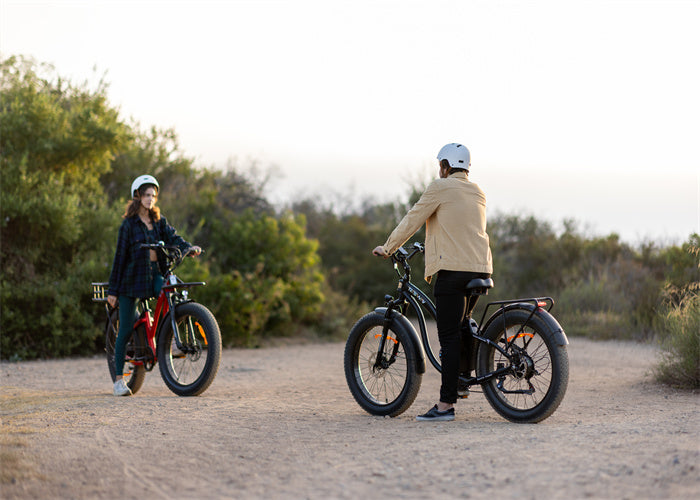As urban centers grow denser and the quest for sustainable living intensifies, electric bikes (e-bikes) have surged in popularity, offering a green, efficient, and enjoyable mode of transportation. Recognizing the diverse needs of riders, legislators have introduced classifications for e-bikes, paving the way for tailored regulations and usage.
Classifications of Electric Bikes
Electric bikes, a transformative evolution of the traditional bicycle, incorporate electric motors to assist with propulsion. The concept, dating back to the late 19th century, has evolved significantly, leading to the modern e-bike. To harmonize with traffic laws and ensure rider safety, e-bikes are categorized into three classes:
- Class 1: Offers pedal-assist up to 20 mph, with the motor engaging only when the rider is pedaling.
- Class 2: Features a throttle-assisted motor up to 20 mph, allowing for propulsion without pedaling.
- Class 3: Provides pedal-assist up to 28 mph, with a speedometer required, and is primarily designed for road use.
How Class 1, 2, and 3 Electric Bikes Are Different
The distinction between Class 2 e-bikes and their Class 1 and Class 3 counterparts centers around the mode of motor assistance each provides, catering to different preferences and needs:
Class 1 E-Bikes: Motor assists while pedaling, enhancing effort without overtaking it, capped at 20 mph. Ideal for cyclists seeking additional power on hills or for longer distances while still engaging physically with the ride.
Class 2 E-Bikes: Include a throttle mechanism, allowing riders to move without pedaling, with assistance also limited to 20 mph. This feature suits those desiring a break from pedaling, whether due to fatigue, preference for a leisurely ride, or when carrying cargo. Electric bicycles like TESWAY basically are lass 2.
Class 3 E-Bikes: Offer pedal assistance up to 28 mph, focusing on speed and efficiency for serious commuters or enthusiasts. This class often comes with age restrictions, helmet requirements, and may be limited to road or bike lane use due to its higher speed capability.

How Does a Class 2 Electric Bikes Work?
A Class 2 e-bike operates through a combination of electric power and traditional pedaling, with its most distinctive feature being the throttle mechanism. This throttle allows the rider to engage the bike’s electric motor without pedaling, providing direct propulsion up to speeds of 20 mph. The heart of a Class 2 e-bike is its electric motor, which is powered by a rechargeable battery. When the rider activates the throttle, electrical signals are sent to the motor, instructing it to drive the bike forward. Are you still hesitating between a regular bike and an electric bike? This can help you make the best choice.
This functionality is particularly advantageous for navigating uphill terrains or starting from a standstill, offering an effortless boost that can make cycling more accessible and less daunting. Despite this electric assistance, riders can still choose to pedal traditionally, using the motor assistance as a supplement to their own power, which can extend the bike's range and battery life. This dual-mode capability ensures that Class 2 e-bikes cater to a wide range of preferences and needs, blending the benefits of electric propulsion with the option for a manually engaged cycling experience.
Essential Tips for Class 2 Electric Bikers
When using Class 2 e-bikes, safety and legal awareness are paramount. Always wear a helmet, as it significantly reduces the risk of head injuries. Laws governing Class 2 e-bikes vary by state, so it's crucial to familiarize yourself with local regulations. Some areas may restrict the use of throttle-powered bikes on certain trails or bike paths, while others may have specific requirements riding. Additionally, the age limit for riders and whether registration or insurance is required can differ. The classification of e-bikes varies significantly across states, with some treating them akin to traditional vehicles, affecting requirements for licensing, permits, and the use of public roadways. Understanding these laws ensures not only your safety but also compliance with local regulations, enhancing your riding experience and preventing unnecessary fines or legal issues.
Benefits of Riding an Electric Bikes
Riding an e-bike, regardless of class, comes with numerous benefits:
- Sustainability: E-bikes offer an eco-friendly alternative to fossil fuel-powered vehicles, reducing carbon emissions and contributing to cleaner air.
- Health: They provide moderate physical activity, improving cardiovascular health and fitness levels.
- Economy: E-bikes can significantly reduce transportation costs compared to cars, in terms of both fuel and maintenance.
- Accessibility: They make cycling more accessible to a broader range of people, including those who might be deterred by physical limitations or the challenge of hilly terrains.

Ride Smart, Choose Right
When considering the purchase of a Class 2 e-bike, several key factors should guide your decision to ensure that you select a bike that best suits your needs and preferences:
Battery Range and Life: Consider how far you plan to ride on a single charge. Look for a bike with a battery that can cover your daily commute or preferred distance with some reserve. Also, check the battery's lifespan and replacement cost.
Motor Power: The motor's wattage will influence your bike's ability to tackle hills and accelerate. Ensure the motor is sufficiently powerful for your typical routes and riding conditions.
Comfort and Fit: Test ride bikes to find one that feels comfortable. Pay attention to the frame size, seat, handlebar height, and the overall ergonomics of the bike.
Weight and Portability: Class 2 e-bikes can be heavy due to their motor and battery. Consider the bike's weight if you need to carry it upstairs or lift it frequently. Some models offer foldable designs for easier transport and storage.
Throttle and Pedal Assist Options: Ensure the throttle action is smooth and the pedal assist levels are adjustable to suit different riding conditions and preferences.
Durability and Build Quality: Look for a bike made with high-quality materials and components. A durable frame, reliable brakes, and sturdy tires are crucial for safety and longevity.
Safety Features: Check for integrated lights, reflective materials, and braking systems. An effective braking system is essential for safely navigating through traffic and different terrains.
Price and Warranty: Balance your budget with the features and quality you desire. A good warranty can offer peace of mind, covering potential repairs or defects.
Local Laws and Regulations: Familiarize yourself with local e-bike laws, including any restrictions on throttle use, speed limits, and areas where e-bikes are permitted or prohibited. Click to learn about the law!
Taking these factors into account will help you find a Class 2 e-bike that not only meets your expectations but also provides a safe, enjoyable, and practical mode of transportation.
Find Your Perfect e-Bike at TESWAY
Whether you're searching for the ease and convenience of a throttle-assisted ride, the health benefits of pedal assistance, or the sheer joy of exploring your surroundings in a new and exciting way, TESWAY has the perfect e-bike for you.
FAQs
Can I ride a Class 2 electric bike without using the throttle?
Yes, you can ride a Class 2 e-bike using pedal power alone, similar to a traditional bicycle, or use the pedal-assist feature without engaging the throttle.
Do I need a license to operate a Class 2 electric bike?
In most jurisdictions, no license is required to operate a Class 2 electric bike. However, it's important to check local regulations as requirements can vary.
How long does it take to charge a Class 2 electric bike's battery?
Charging times can vary, but on average, it takes about 4 to 6 hours to fully charge a Class 2 electric bike's battery from empty.







Share:
The Ultimate Guide to Choosing the Best Bikes for City Riding
What is the Best Class 2 Electric Bike?